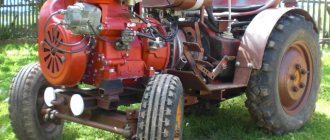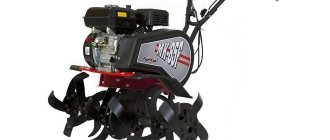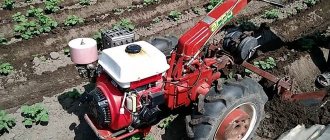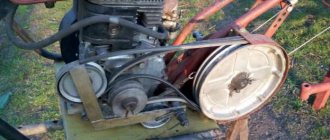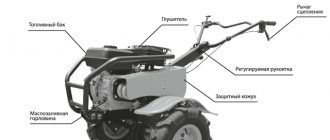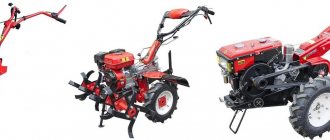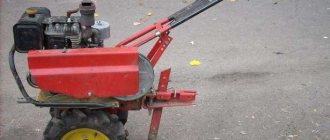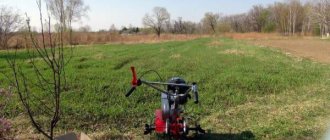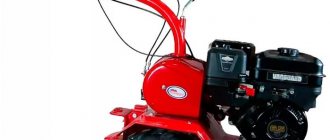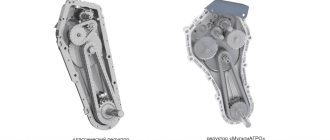Sooner or later, any technology fails in the system. The reasons for such troubles can be very different: failure to comply with operating conditions, wear of old parts, poor-quality assembly of the unit itself, etc. In any case, no matter what of these reasons, the equipment needs to be repaired. Today we will talk about all sorts of malfunctions with Agro walk-behind tractors. We will try to figure out the repair without contacting service centers.
Attachments
The walk-behind tractor of the same name is rarely purchased in the basic configuration. After all, in order to appreciate the huge range of Agro’s capabilities, it is necessary to use it with various auxiliary models. Of these, we note only the most common elements recommended by the manufacturer:
- Mounted unit ANM-4
- Mower (segmental) KN-1
- Mower (regular) – KM 0.5
- grouser
- Hiller
- Snow removal product SM-2B
- Potato digger
- Potato planter
- Cart PTM-500
- Milling cutter (several pieces)
- Brush ShchP-09
- Blade The basic package includes only pneumatic wheels and a universal hitch that allows you to connect attachments from third-party brands.
Prices in Russia
The Agro walk-behind tractor is widely in demand in branded stores, as well as in the second-hand market. The equipment has been on the market for quite a long time, so there are a huge number of offers on the secondary market. Thus, the average price of a used copy today is 25 thousand rubles. The most complete version will cost about 45 thousand.
As for a new car, everything is much more complicated. Taking into account its high popularity, the new Agro walk-behind tractor in the basic version costs no less than 55 thousand rubles. Often the price reaches 60 thousand rubles.
Agro successfully competes with domestic and imported models, and is relatively inexpensive. In terms of characteristics, this walk-behind tractor can be compared with the Belarus-09N, Burlak 10 DF, and Belarus 08 MT machines.
Attachments
Motoblocks of the Agro brand can perform different work, such as:
- plow the land;
- cultivate;
- spud;
- make even beds;
- remove snow, sweep the area;
- transport construction waste, crops, snow, and much more.
Most often, owners purchase additional attachments for the Agro walk-behind tractor, such as potato planters and potato diggers. With them you can plant a crop very quickly and then dig it up. In this case, the percentage of damage to tubers will be minimal. You will need to collect potatoes from the surface of the ground.
Trailers allow you to transport different loads. The lugs create better grip on the ground and also make the equipment heavier. With the help of mowers, you can cut grass on lawns or make hay for animals for the winter. Keep in mind that mowers are different for different purposes.
The cost of a walk-behind tractor will depend on which attachments it is sold with. If you buy the unit itself, the price will therefore be much lower than with the included attachments. Many craftsmen, to save their money, make attachments themselves.
What if the gearbox chain fails?
Such a breakdown will be indicated by stopping the rotation of the power take-off shaft of the walk-behind tractor, and the gearbox itself will simply jam. It is possible that the chain itself has burst, then it just needs to be replaced and the PTO will resume its operation. Also, very often owners of walk-behind tractors have problems with adjusting attachments. For example, adjusting a plow on a walk-behind tractor involves the following actions:
- We secure the hitch with 1 kingpin, where the play in the horizontal position should correspond to 5° - 6°.
- We adjust the plowing depth. The norm would be somewhere deep into the ground by 5 - 7 cm.
- Adjusting the angle of attack. Place the walk-behind tractor with the plow on a flat surface. We unscrew the adjusting screw so that the plow touches the ground. And unscrew the screw back until the back of the canopy rises 2.5 cm from the ground.
These are the main points of plow adjustment that need to be made when installing it. Of course, this kind of breakdown of the Agro walk-behind tractor, such as turning on the power take-off shaft or adjusting the clutch, can be eliminated with your own hands without much difficulty. Also, if the Agro walk-behind tractor malfunctions, you should contact its instruction manual, where all problems with such equipment should be described in more detail. If you still understand, for example, that you need to disassemble the imported engine of your unit, that you are not sure that you will do it correctly, then it is still better to turn to specialists. Still, service centers can do detailed diagnostics and determine where the problem is with 100% accuracy. So, when in doubt, it is better to turn to professionals.
Engine parameters
The heavy walk-behind tractor "Agro" is equipped with an 8-horsepower gasoline engine. Number of cylinders - 1, stroke - 4. According to technical indicators, the device can be classified as a professional device. Its endurance and power allow the machine to be used on areas with a total area of up to several hectares. Engine cooling system: air blowing.
Engine model: gasoline UMZ-341. The parameters and general design of the engine are in many ways similar to the Japanese Honda engine of the GX240 brand, the same number of horses, engine life, endurance and ability to work for many years without breakdowns. The compression ratio is reduced, so the walk-behind tractor can easily operate even on inexpensive gasoline such as AI-76, 80 or 92.
Gasoline engine HONDA GX 240 Engine UMZ-341
The cylinder in the engine is located in an inclined manner, the angle of inclination is 25 degrees. The engine is lubricated with oil in a certain way, namely: there is no splashing of oil. A special pump supplies oil (under pressure, using a pump) after filtration to all contacting parts of the engine. Engine capacity is 333 cc.
Operating and Maintenance Instructions
Before you start using the Agro walk-behind tractor, read the operating instructions. Keep the instructions for the entire period of use of the unit.
Oil and fuel
- engine oil - for air-cooled carburetor engines, according to the season, for example, SAE15W/30;
- gearbox oil - SAE80/W90;
- fuel - gasoline AI-86, 90;
- lubricants - Litol-24, synthetic grease, fatty grease.
First launch and run-in
Before the first start, set the gearbox lever to neutral and the PTO to the disengaged position.
Break-in recommendation from the manufacturer: at least 40 operating hours.
It is allowed to perform light types of transport work (with a light trailer load), as well as work with a walk-behind tractor at partial engine load.
Main causes of breakdowns
The Agro walk-behind tractor may not start for several reasons:
- insufficient amount of fuel;
- insufficient oil level;
- hypothermia of the walk-behind tractor, too low air temperature (in winter);
- more serious faults requiring repair.
The most common problems:
- oil leakage (can occur due to wear of the cuffs or due to their damage, can be eliminated by replacing the cuffs);
- the clutch is not completely disengaged (the clutch lever moves freely, the cable is pulled too far, this can be eliminated by replacing or shortening the cable, as well as adjusting the lever to normal);
- there is no full torque (perhaps the pressure spring is weakened or the drive cup is worn out, this can be eliminated by replacement or adjustment).
Design
The design of the walk-behind tractor is simple; repairing the unit in the field is not difficult; you can always find the necessary spare parts on the market at a reasonable price. Characteristics of "Agro":
- case length 1182 mm;
- height 855 mm and 1110 mm;
- ground clearance 252 mm;
- turning radius 1210 mm;
- non-adjustable track width 610 mm;
- the structure weighs 162 kg.
This unit has its drawbacks, but there are noticeably more obvious advantages. The walk-behind tractor is designed for a processing depth of up to 205 mm, while the traction impulse can reach 100 kgf. The walk-behind tractor can transport half a ton of cargo at a speed of 15.2 km/h. The engine is equipped with a UMZ-341 carburetor, which runs on low-octane gasoline. The motor has a “progenitor” - the Honda GX240 engine. The power plant is also capable of operating on 92 gasoline.
The engine has:
- volume 0.3 liters;
- power 8 horsepower;
- torque 17 N/m;
- There is only one cylinder in the engine, its diameter is 79 millimeters.
Fuel is consumed on average two liters per hour, its actual consumption is 395 (289) g/kW per hour. The oil is supplied under pressure using a pump, passing through the filter, it is well cleaned.
Additional dimensions:
- track 610 mm (changes possible up to 755 mm);
- turning radius 655 mm;
- does not have a frame frame, instead there is a transmission housing;
- wheel parameters 6x12 inches;
- tire pressure 0.09 -14 MPa.
The starter for a walk-behind tractor is the most important element; without it, the engine cannot operate normally. The part often fails; replacing it is easy. Also in the power plant there is a backup starter - an electric starter (on the latest models there are two of them). You can also start the engine manually
It is important to note that the battery capacity affects the duration of the starter operation.
If a strange grinding noise is heard in the gearbox, this is a signal that you need to add oil to the gearbox. It also happens that the oil is of poor quality. Therefore, it is best to use the lubricant recommended in the operating instructions. If, while using the walk-behind tractor, complaints arise about the gearbox, then it should be disassembled and the gear teeth should be straightened. It often happens that the teeth need to be replaced. To correctly adjust the axial arrangement of the shafts, you should install another rings for fixation. Bearings also often wear out and should be replaced.
The unit has a 6.2-liter fuel tank, the engine consumes about three liters per hour of operation. Much depends on the volume of valve operation and the load on the engine; consumption can reach four liters. On the market, walk-behind tractors are sold on average from 25 to 30 thousand rubles; there is always a steady demand for such equipment. A new, fully equipped unit will cost at least 46 thousand rubles. If the equipment is “zero”, that is, completely new, then the price can reach up to 65 thousand rubles.
Analogues of Agro with which it successfully competes:
- "Belarus-09H";
- "Burlak 10 DF";
- "Belarus 08 MT".
Transmission malfunctions and ways to eliminate them
Every modern mechanized device has a transmission, and if there are certain malfunctions, it is not at all necessary to immediately buy a new element and change the transmission. In practice, there are a lot of mechanism malfunctions that can be eliminated without replacement. Let's take a closer look at the most common types of breakdowns:
- A hum when operating at high speeds or a metallic rustle (here you need to immediately change the oil for the Agro walk-behind tractor in the gearbox).
- Intermittent movement and kicks when shifting gears (it is necessary to replace the oil filter and add fresh oil).
- A strong metallic crack and a subsequent jolt with the cessation of independent movement (the clutch fork is being changed).
- Gears do not shift (there is a malfunction in the clutch, which requires its overhaul or full replacement).
- A strong metallic crunch while moving (lack of oil in the box, and in addition the need to completely overhaul the unit and change the lubricant).
In practice, there are still a lot of faults that you can fix yourself, but correcting them requires a lot of physical effort, as well as the necessary knowledge and skills, which is why it would be better to take the device to a service center, where specialists will carry out full diagnostics and repairs.
In this video you will learn how to change the oil:
Important. Any owner of a motor cultivator must know the volume of the transmission and the required amount of oil for the correct operation of the mechanism, otherwise large material investments will be required.
Specifications
The overall dimensions of the Agros walk-behind tractor, with the steering wheel positioned on the same axis with the steering bar, are: length – 1800 mm; width – 850 mm; height – 1100 mm. The walk-behind tractor has the following weight: structural – 150 (+/-3) kilograms; operational - 160 kilograms. Other overall parameters of "Agros" are as follows:
- Track – 600 mm. (with inserts “42T 001.17.00.001” it can be changed up to 700+50 mm).
- The turning radius at the smallest track is 600+50 mm (along the axis of the outer wheel track) – 1.2 m.
- The vertical ground clearance is at least 250 mm.
- The maximum ford depth is 0.3 m.
- The frame is frameless and consists of a transmission housing.
- Tire size: 6x12 inches. Tire air pressure: 0.08 - 0.12 MPa (0.8 - 1.2 kgf/cm2).
- Traction force – 100 kgf; processing depth – 200 mm.
Engine of the Agros walk-behind tractor
The Agros walk-behind tractor is equipped with a 4-stroke single-cylinder carburetor gasoline unit of the UMZ-341 model with a power of 5.9 kW (8 hp) at 3600 rpm, with a forced air cooling system. In its design, this engine, developed in Ufa, is close to the Japanese Honda GX240 engine. The reduced compression ratio allows it to operate on gasoline of various classes (from low octane to high octane).
Important: What is better to choose a chainsaw or an electric saw?
The location of the cylinder in the engine is inclined, at an angle of 25 degrees to the horizontal. The direction of rotation of the output shaft is left (counterclockwise), according to GOST-22836. A special feature of the UMZ-341 engine is its modernized lubrication system. The oil does not splash, and after filtering in a replaceable automotive-type filter, it is supplied under pressure to the rubbing elements through an oil pump.
Other characteristics of the UMZ-341 engine:
- Overall dimensions – 490 x 440 x 375 mm;
- Working volume – 333 cm3 (0.333 l);
- Maximum torque – 17.2 Nm;
- Compression ratio – 7.4;
- Cylinder diameter – 79 mm; piston stroke – 68 mm.
The K-45R carburetor is a float-type carburetor with a horizontal diffuser. Ignition system - “MB-23U”, contactless magneto. The engine is started by a manual starter with a self-retracting cord. The power of the built-in electric generator for UMZ-341, at a rotation speed of 3600 rpm, is at least 25 watts. The engine weight is 35 kilograms.
The fuel tank capacity of the Agros walk-behind tractor is 6 liters per hour. In this case, the nominal fuel consumption is 390 g/kW per hour (287 g/hp per hour). On average, this equipment consumes about 2 liters of fuel per hour of operation. Two types of oil are required - motor (1.2 liters in the engine crankcase) and transmission (2.5 liters).
Initially, the engine of the Agros walk-behind tractor was intended to work with low-octane gasoline - A-76 and A-80. But to convert the engine to AI-92 gasoline, the manufacturer recommends replacing the A11-3 spark plug with an A17B spark plug, and adjusting the ignition timing, shifting it by two degrees, counterclockwise.
Transmission
The Agros walk-behind tractor has a strong and reliable transmission, which includes a gear reducer, a dry cone clutch and, as already noted, a differential with forced locking, which provides improved maneuverability. The walk-behind tractor is equipped with four gears with reverse. (Total – four forward and two back). When reverse gear is engaged, only second and fourth gears are available, operating in a “lower” version - when their rotation speed is approximately halved.
The gearbox, final drive and differential are housed within one housing. In addition to these elements, it also houses the power take-off shaft and the entire gear shift mechanism. The use of the differential ensures rotation of the drive wheels at various angular speeds, and this plays a beneficial role when turning the walk-behind tractor, or while moving the Agros on uneven surfaces.
Technical features of transmission components:
- Clutch – friction, conical “dry” type, permanently closed, with manual control;
- The main gear is a pair of bevel gears with circular teeth;
- Differential - gear, bevel, with two satellites with forced locking;
- The final drives are single-stage, with spur gears.
Possible causes of breakdowns
- Wear of parts. To avoid this problem, it is necessary to inspect the unit before each start of work.
- Jerking while performing work. In this case, you need to check the tire pressure and adjust the hitch correctly.
- Strong vibrations. To do this, tighten the bolts.
- Difficulty starting the engine. You can solve the problem as follows: check the condition of the oil and parts, tighten the bolts.
- Problems after winter downtime. In this case, the wires quite often oxidize and debris accumulates in the carburetor. To prevent the situation, you should check all parts before use and only then start work.
Change of oil
This process is carried out without the need to dismantle the box. As a rule, for this purpose the device is warmed up to operating temperature. Next, the oil seal is unscrewed and all the lubricant present is completely drained. At the very end, the filter is screwed together. You will need to screw the cap back into place. After this, you need to fill in fresh fluid and tighten the filter apparatus.
Important. During this procedure, you will need to use a special probe to check the amount of fluid in the transmission mechanism; there are corresponding minimum and maximum notches.
Attachments for the unit
There are a large number of different devices on sale that can be installed on Agros. Among them:
- hiller (single-row or double-row);
- potato digger;
- harrow;
- blade (shovel);
- trolley with a seat for the driver and a body for luggage. The seat is usually used simple, plastic - it’s cheaper, and in addition it’s easier to clean. But some owners, in pursuit of comfort, install seats from decommissioned cars;
- a snow blower for the Agros walk-behind tractor will allow you not to buy a separate unit, without losing the quality of cleaning the surface from snow;
- caterpillars. Installed instead of wheels, they significantly increase the level of maneuverability.
Some of the accessories are specifically designed for use with this unit. Others are universal and suitable not only for Agros, but also for models from other manufacturers.
Before purchasing, be sure to check the compatibility issue with the seller.
Areas of application and design of the Agro walk-behind tractor
The Agro walk-behind tractor belongs to the class of heavy agricultural equipment. The model is intended for active use in both small and large areas.
The tasks that the Agro walk-behind tractor successfully copes with include:
- effective cultivation of the site, regardless of the type of soil and the number of weeds;
- hilling beds planted with root crops and other agricultural crops;
- weeding between rows and beds;
- mowing vegetation of different heights and thicknesses;
- clearing the area of snowdrifts;
- planting and harvesting potatoes;
- harrowing or plowing areas with virgin soils;
- transportation of luggage and gardening equipment with a total weight of up to 500 kg.
One of the main advantages of the Agro walk-behind tractor is its impressive weight. Thanks to the large mass, the equipment is pressed more tightly to the ground, which allows it not to slip and loosen the soil better, and also completely eliminates the unit’s sliding on the ice surface.
To manufacture the Agro walk-behind tractor, a standard single-axis design is used. The design of the model includes a power take-off shaft. In order to increase productivity, the manufacturer included a differential with manual locking in the walk-behind tractor configuration. This design feature allows the power of the unit to be evenly distributed on both wheels to improve maneuverability when moving up and driving in hard-to-reach places. A well-designed transmission of the walk-behind tractor allows it to move at any of four forward and one reverse speeds.
The engine of the Agro walk-behind tractor is equipped with a large fuel tank with a volume of approximately 5 liters. The large capacity of the tank in the design of the unit is due to its consumption of a significant amount of fuel - on average this figure is 2 l/h. work. All motor parts are made of durable metal alloys that are highly resistant to wear and corrosion.
The steering wheel of the Agro walk-behind tractor can be adjusted to the height of the operator. If necessary, it can be shifted relative to the original position in the vertical and horizontal plane by 30 ⁰. This feature significantly increases control accuracy when moving in hard-to-reach places.
Disassembly and assembly
In order to disassemble and subsequently reassemble the transmission, it is recommended to adhere to the following series of tips:
- The mechanism is first disconnected, and in addition all the oil is drained from the device;
- the next step is to unscrew the oil filter, and also completely dismantle the clutch and gearbox;
- Next, the protective box is removed and the transmission unit is subsequently disassembled with the removal of gears and shafts;
- then the device is thoroughly washed using a special composition;
- subsequently, after drying, a full assembly is carried out, and in addition, damaged elements are replaced if necessary;
- At the final stage, the device is mounted in place, after which fresh oil is poured.
Engine UMZ - 341 for the Agro walk-behind tractor - technical specifications, instructions, malfunctions
In 1999, OJSC Ufa Engine-Building Production Association began manufacturing a new generation carburetor engine, UMZ-341, developed by factory specialists. This single-cylinder, four-stroke engine produces 8 hp. in all respects it corresponds to the best world analogues, and in Russia it simply has no equal. It was originally created for the Agros walk-behind tractor.
Engine for walk-behind tractor Agro UMZ-341 - operating manual download
Catalog of spare parts for the UMZ-341 and UMZ-341E engines - download
To convert the engine to AI-92 gasoline, it is necessary to replace the A11-3 spark plug with an A17B spark plug and adjust the ignition timing, moving it 2 degrees counterclockwise.
Download guidelines for converting the UMZ-341 engine and its modifications to AI-92 / AI-80 gasoline from the manufacturer (this information is from the manufacturer’s website)
Detailed technical characteristics of the UMZ-341 engine
The engines are designed to operate under the following conditions:
Important The most popular homemade products from gasoline and electric trimmer engines
— ambient air temperature from minus 20 to plus 40°С.
— relative humidity of the ambient air up to 98% at a temperature of plus 25°C
The UMZ-341 and UMZ-341E engines are a single-cylinder, four-stroke, gasoline, carburetor engine with overhead valves, spark ignition, with a horizontal engine shaft, with an inclined cylinder, and has a centrifugal all-mode speed controller and a balancing shaft.
The UMZ-341 engine is designed for installation on the Agro walk-behind tractor manufactured by JSC UMPO, supplied to the domestic market and for export to countries with temperate climates
The UMZ-341 E engine is made on the basis of the base model UMZ-341 and is intended to drive the AB-4 electric unit.
ENGINE ADJUSTMENT
Adjusting the UMZ-341 carburetor
The engine carburetor is adjusted in case of unstable engine operation.
1 Start the engine and warm it up without load for 2 to 3 minutes.
2 Turn out the idle speed adjusting screw 8 (Figure 3) to a position at which the engine begins to run unstably. Turning the screw slowly, achieve stable, uninterrupted operation of the engine.
3 By rotating the thrust screw 10, set the throttle valve to the minimum opening position, at which the engine runs stably at the minimum idle speed, then by rotating the adjusting screw 12 achieve a maximum increase in engine speed. Use the stop screw 10 to adjust the regulated speed
4 If gasoline is poured through the float chamber of the carburetor, it is necessary to remove the float chamber and check the condition of the float, shut-off needle, and valve seat
Carburetor
Adjusting the thermal valve clearances on the UMZ-341 engine
Adjust the gaps between the valve and the rocker arm on a cold engine in the following sequence
— remove covers 4 and 5 of the cylinder head and the starter;
— check the tightness of the cylinder head nuts;
- set the piston to the top dead center (TDC) of the compression stroke,
— loosen lock nut 6 and bushing 7 of rocker arm 8 and, inserting a 0.08 or 0.1 mm feeler plate between the heel of rocker arm 8 and the end of valve 3, tighten bushing 7 so that the feeler plate fits into the gap without biting; tighten lock nut 6;
— check the thermal clearances between the fifth of the rocker arm and the end of the intake and exhaust valve stems
Install the cylinder head and starter covers in place, securing with nuts.
Note: To more accurately install the piston at top dead center, it is necessary to remove the fan casing and align the “E” mark on the end of the flywheel with the “G” pin on the crankcase housing (Figure 1, sheet 3).
Engine device
Engine malfunctions
We present the first list of possible malfunctions and methods for eliminating them from the user manual; you will learn more in detail by studying the instructions in full.
Replacing the UMZ 341 engine on an Agro walk-behind tractor with a Chinese Lifan engine - video
How to replace the UMZ-341 engine installed on an Agro walk-behind tractor with a Lifan? Many people want to replace this engine with a more modern one; this video is very useful for them.
This article describes the adjustment of the walk-behind tractor, namely its main parts: carburetor, valves and fuel system. The process is not easy, so we have also attached several photos and videos.
Operating rules
Before you start working on this unit, you should thoroughly study what the operating instructions contain. The engine of the Agro walk-behind tractor is unpretentious to fuel; it is permissible to use the following brand of gasoline:
- AI-80;
- AI-92;
- AI-95.
The second Lifan engine requires only 92 and 95 marks
It is important that the fuel is clean and free of impurities. The tap is located 1.6 cm from the bottom of the tank, so you should keep in mind that the fuel located at the bottom remains in the tank and does not enter the engine
A similar design was made with the intention that as many foreign impurities as possible would enter the engine. Before starting work, you should fill at least half of the tank.
It is better to use M-5z/10G1 oil in the cold season. When the weather is warm outside, it is best to use oil M-6Z/12G1. It is also possible to use universal compounds 10W-30 and 15W-30. It is recommended to change the oil every hundred hours of operation of the unit. The crankcase has a volume of 1.22 liters. Transmissions are usually lubricated with standard Nigrol, but any equivalent labeled 80W-90 will also work. The transmission tank can hold 2.55 liters of fuel.
If we talk about controls, the levers are extremely unpretentious in operation, their repair and adjustment are simple. For lubrication, ordinary grease or its equivalent is quite suitable.
At the beginning of work, you should pay close attention to the correct filling of fuel: not only gasoline, but also oil is poured, otherwise there is a risk of engine damage. After purchasing a new device, it is recommended to “ride” a little empty at the very beginning so that the dynamic components get used to each other
It is useful to carry out some simple field work using only 50% of the power of the power plant.
The K45R carburetor forms the fuel mixture; the importance of its work cannot be underestimated. At the beginning of the warm season, this important unit should be configured and adjusted
To do this, the following steps are taken:
- the screws that are responsible for adjusting the gas are removed, then they need to be tightened back a couple of turns;
- The engine warms up for about 15 minutes, while the lever responsible for the operation of the power plant is placed in its extreme position.
- using the throttle, the minimum idle mode of the engine is set;
- adjustment is made using screws (if you unscrew too many of them, more gasoline will flow).
Installing the Lifan engine on the Agro walk-behind tractor
The Lifan engine with an adapter is suitable for the Agro (Agros) walk-behind tractor. To replace you will need to prepare:
- pulley;
- throttle cable;
- adapter washer;
- crankshaft bolts.
If the mounting points do not match, you will have to drill new holes in suitable places.
When the unit frame is not compatible with the motor, a transition pad is used. Steel products are more suitable for these purposes - they reduce the risk of heating the equipment and burning the belt.
Installation is carried out according to a step-by-step algorithm:
- It is necessary to remove the protection cover with belts.
- Unscrew the bolts that secure the belt.
- Remove the bolt from the crankshaft.
- Remove the pulley.
- After removing the air purification filter and disconnecting the gas pedal cable, all that remains is to remove the old engine.
- A new part is placed in the vacated space. If it is necessary to use a transition pad, then it is not screwed in immediately - only after adjusting the drive belt.
- Next, the pulley is placed on the shaft and the bolts are tightened.
- After tensioning the belt, the degree of tension is adjusted by the engine.
- The bolts on the transition area are fully tightened.
- Then belt stabilizers, an air purification filter, and a gas cable are installed.
- The motor is firmly attached last.
When installing yourself, you need a full set of special tools and equipment.
Lifan engine
We also recommend reading an interesting article that contains all the necessary information about Lifan engines for walk-behind tractors, from design and types, to detailed installation instructions.
Minitractor from the Agro walk-behind tractor
The Agro or Agros walk-behind tractor is very popular among farmers. The reason for this is its high-quality assembly, durability, and functionality. Agro and Agros are two names for one model.
This walk-behind tractor is a development of a plant in Ufa - Ufa MPO. “Agros” have been produced in Ufa since 1998, soon after the start of production the model was called “Agro”, but among farmers it is known by both names.
Which model to take as a basis?
The power of "Agro" is 8 hp. or 5.8 kW, has gained great popularity for many reasons, the main one of which is the build quality, Russian production, as well as the high quality of the parts from which the walk-behind tractor and high power are made.
The walk-behind tractor is equipped with a UMZ-341 carburetor engine (4 strokes, 1 cylinder, fueled with gasoline). In terms of characteristics and operating parameters, the engine is similar to the Honda GX240.
Due to its high power and good traction performance, the Agro walk-behind tractor is a popular base for conversion into a mini tractor. Since the manufacturer has only one model in the Agro model range, it is used as the basis for creating a mini tractor. The weight of the walk-behind tractor is 160 kg.
Farmers who have independently converted a walk-behind tractor into a mini tractor also recommend using weights with an average weight of up to 40 kg.
We bring to your attention a video about the Agro walk-behind tractor, converted into a homemade mini tractor:
What is required to create a mini tractor from a walk-behind tractor?
To make a mini tractor with your own hands, you will need not only the Agro walk-behind tractor, but also a certain set of additional components, namely:
- welding machine;
- wheels (you can use wheels from VAZ 2106);
- operator's seat or car seat;
- steering wheel;
- steel profiles, steel sheets;
- fasteners (bolts, nuts, angles);
- grinder with discs “for metal”;
- electric drill;
- hammer and other tools;
- bearings, bushings;
- metal pipes of the required diameter;
- hubs with brakes.
Figure 1. Design diagram of a homemade mini tractor made from walk-behind tractors
This diagram is not a direct guide to action and is an approximate drawing for creating a homemade structure.
Mini tractor made from Agro walk-behind tractor
This is interesting: Agat walk-behind tractors: models, their characteristics, description, video
repair of MB "Agro"
I propose to post information here about analogues/replacement spare parts, methods/methods of repair, disassembly/assembly, setup, etc.
translation to AI-92, factory method, -
when disassembling the clutch I use 2 studs M6 * 100 mm:
- I screw in instead of 2 bolts, counter with a nut from the bottom, 2 washers on top and screw on the nut;
- I unscrew the remaining 2 bolts;
- I drive the nuts one by one (it is better to use an extended socket with a ratchet) and halve the clutch;
- assembly in reverse order.
- Catalog of assembly units for the Agro walk-behind tractor - ;
- Catalog of assembly units for the UMZ-341 engine: - ;
- Catalog of assembly units for soil tiller - ;
- Catalog of assembly units for mower KN 1.1 -
birasa, thank you, but I’ve been driving a 92 for a couple of years now and haven’t adjusted anything, now I’ll do it
please tell me where to put the wheels (bigger) - the cutter does not always bury itself in the ground (if the ground is hard)
vano5300 wrote: please tell me where to put the wheels (bigger) - the cutter does not always bury itself in the ground (if the ground is hard)
In the fall, plow with a plow and in the spring with a rotary cutter, I do this, everything is on the original wheels.
mastera, if I have to plow everyone, I won’t have enough time or energy. I’ll hang out on it
vano5300 wrote: if everyone plows, I won’t have enough time or energy. I’ll hang out on it
And I have a sabbath both in the spring and in the fall, the clients are standing
data.
Does anyone know about the rotary plow on AGRO
Good afternoon After six months of not using the Agro walk-behind tractor, the clutch stopped working (the clutch lever is released). Has anyone encountered such a situation? What happened after such a stop and how to fix the problem? Tell me, best regards, Sandi.
Sandi wrote: Good afternoon! After six months of not using the Agro walk-behind tractor, the clutch stopped working (the clutch lever is released). Has anyone encountered such a situation? What happened after such a stop and how to fix the problem? Tell me, best regards, Sandi.
Sandi, The discs are stuck along the way, remove the engine and look at the clutch.
Sandi wrote: Good afternoon! After six months of not using the Agro walk-behind tractor, the clutch stopped working (the clutch lever is released). Has anyone encountered such a situation? What happened after such a stop and how to fix the problem? Tell me, best regards, Sandi.
Sandy, this is due to little work with a walk-behind tractor or exposure to moisture. The disks are stuck to each other. I’ve never had anything stick before after being left idle for half a year. Now in winter the MB works, I use AGRO with snow blades. If the walk-behind tractor works a lot in the spring-autumn season and its clutch engages quite smoothly and without noise, it will not stick during the winter. It’s the same as with a plow, if it shines like a mirror, then the earth doesn’t stick. If the metal disk is matte and not polished by long, smooth operation, then the clutch lining is also rough and such a clutch will stick faster than with a mirror disk where the lining corresponds to it.
And without removing the engine. Is it possible to move the disks under load?
Sandi wrote: And without removing the engine. Is it possible to move the disks under load?
Sandi, I don’t think so, the neighbor’s ones were slightly separated.
I have been using Agros since 2001, a year later I worked out the method of setting the starting flap on my original carb to work with a variable load (start with a loaded trailer, a snow blower on compacted or wet snow, etc.), (and I also rearranged the TsRO-carb rod on the lever CRO into the hole closest to the axis for the spring from the throttle cable lever, drilling it to 5 mm): on a warm engine and a tuned carb with the starting flap open, set the maximum speed and, by covering the starting flap, achieve stable operation with smokeless exhaust (usually at an angle of up to 30 degrees)
Sandi wrote: And without removing the engine. Is it possible to move the disks under load?
Sandy, it’s easy to remove - unhook the wires and gas cable, unscrew the 4 nuts and go. You can then drill a small hole in the clutch housing from below to drain the condensate
Technical characteristics of the Agro walk-behind tractor
As you know, on the agricultural machinery market you can find models from different manufacturers: Chinese, Russian, European. The Agro walk-behind tractor has been produced in Russia for many years, and during this time it has proven itself exclusively on the positive side.
Important Review of semi-professional chainsaw Husqvarna 240
The units perform well not only in working in small areas, but also in processing virgin soil. The power is 8 horsepower, but by upgrading the model and installing another engine, this figure can be significantly increased.
High reliability and durability, ease of operation, endurance - all this is about this device. There is a large selection of different attachments on sale, which will significantly expand the capabilities of the machine.
She weighs 160 kilograms, and that's a plus. After all, the grip on the ground will be very good, especially if you work on heavy soils, such as clayey ones. On the other hand, transportation will be difficult precisely because of the large mass and significant size.
Fuel consumption is 6 liters per hour at maximum loads. On average, equipment will consume about two liters per hour.
The engine has the following characteristics: a four-stroke single-cylinder carburetor engine running on gasoline. It has a forced air cooling system, which allows it to work even in summer without overheating. The low compression level allows you to refuel different types of fuel: from A-76 to AI-95. The manufacturer also worked on the lubrication system. Now the liquid does not scatter in different directions, and after it is filtered, it is supplied by a pump to the elements that rub.
If you read reviews about the Agro walk-behind tractor, you will mostly see positive messages. The unit has the following advantages:
- The equipment is universal in its characteristics, so it is perfect for both vegetable gardens and small farms;
- Very simple controls. You won't have to put any effort into managing it. The motor is so powerful that it moves the equipment itself in the desired direction, and you only have to adjust the path;
- The model is professional, so it copes well with cultivating large areas of land, as well as transporting huge loads;
- Wide bore of attachments. Moreover, the model works great even with homemade tools. Therefore, if you are missing something, you can always do it yourself.
There is also something that causes some difficulties for users. So, the carburetor does not work very well. The car itself is designed for heavy loads, but the carburetor does not agree with this, and you may encounter “floating” speeds.
There are also problems with the fuel tank, which has a flat bottom. It is relatively small in size, but sometimes problems occur with the supply of gasoline to the engine.
Common breakdowns:
- Problems in the gearbox chain;
- Complete waste of lubricant in the ratchet;
- The engine cylinder head gasket wears out;
- The fuel tap becomes clogged;
- Spark plug broken.
If you experience any strange operating problems, immediately turn off the engine and let it cool. After this, open the repair instructions, study it carefully and you can safely begin to search for the problem and how to fix it. In fact, repairing an Agro walk-behind tractor is not as complicated as it might seem at first glance. Even those who have no skills, but have the desire to do everything with their own hands, can handle it.
Advantages and disadvantages
The advantages of this agricultural machinery:
- Easy controls. The power is enough for independent movement, the owner only has control. The weight of the equipment is enough for a good immersion in the ground.
- Reliability and reliability. The unit easily copes with large volumes of work and can operate for several hours without rest. The walk-behind tractor can transport large loads and is suitable for processing large areas of land.
- Maintainability. The cultivator rarely fails, but requires regular replacement of consumables with spare parts that wear out over time. Repair work can be carried out by the owner himself; any specialized store sells spare parts.
The instructions from the manufacturer describe in detail recommendations for repairing the walk-behind tractor and replacing worn parts.
The disadvantages of the technical product include problems with the operation of the carburetor. It does not always cope with the loads, resulting in the effect of “floating” speed.
Due to the fact that the gas tank has a flat bottom, some difficulties may arise in rare cases. Despite the compact size, gasoline is sometimes poorly supplied to the system, and the fuel valve can become clogged.
To solve the problem of these shortcomings, you can replace the main parts with spare parts from other walk-behind tractors.
Equipment with trailer
General information, purpose and design features
For starters, it’s about and “Agro” - absolutely identical walk-behind tractors. Agros is an earlier version, and the design of the model has remained almost unchanged over many years of production.
The car is produced at the Ufa Engine Plant, which was founded in 1925. In the 1920s and 1930s, the company was considered the largest manufacturer of aircraft engines in the USSR. In peacetime, the plant began to master the production of agricultural machinery. The company's workforce now consists of more than 200 people. As for the Agros walk-behind tractor itself, its production began in 1998. The project turned out to be so successful that over the past years, about 40 thousand walk-behind tractors of the same name, as well as various attachments for them, have been produced and sold.
The production of the walk-behind tractor of the same name was completed in 2008 due to a complete stop in the production of all such equipment at the Ufa plant. The fact is that the company began to receive more orders for the production of aviation equipment, which is more profitable. In this regard, the assembly of "Agros" was stopped. However, later the walk-behind tractor began to be produced at another plant, which belongs to the Chamber of Commerce and Industry of Ufa-Mechanika LLC.
The Argos model allows you to efficiently and effectively carry out work on cultivating the soil, planting and digging up root crops and other vegetable crops. The rich basic equipment allows you to perform the required amount of work for the first time. Thanks to the ability to connect various attachments, the walk-behind tractor can be turned into a full-fledged mini-tractor, capable of cultivating the soil to great depths, pumping water, transporting loads, etc.
Agros has a single-axle design with a power take-off shaft. The equipment is equipped with a differential with manual locking
This device is responsible for distributing the load on both wheels, which is very important when driving in difficult to reach areas.
It can be noted without any doubt that the Agros walk-behind tractor, together with mounted options, has wider capabilities. That is why, when choosing this equipment, many people are looking at purchasing additional options that allow them to unlock 100% of the potential of the walk-behind tractor.
Attachments
Complete with trailed and mounted equipment for the Agros walk-behind tractor using a hitch, the unit is capable of performing a wide range of agricultural work, including:
- plowing the site;
- loosening, leveling the soil;
- land reclamation;
- chopping and removing weeds;
- hilling of industrial crops;
- harrowing;
- digging up root crops;
- planting seeds of grain and vegetable crops in the ground;
- mowing vegetation and bushes;
- landscape works;
- snow removal;
- transportation of goods.
The module is also used in housing and communal services.
Walk-behind tractors can be used with attachments, these are:
- plow NP-1;
- Rotary rotary cutter - 20.00.000;
- diggers;
- harrow-cultivator;
- potato planters;
- lugs;
- frontal mowers KN-1, KN-1.5, KN-02;
- 2-row hiller STV;
- snow blower SMB-2;
- trolley-trailer PTM-500.
Each mechanism performs its own operation. A potato digger for the Agros walk-behind tractor digs up root crops. The harrow cuts off the top layers of the earth without turning the soil. A trolley with a load of no more than 400 kg is a single-axle, tipper trailer with a body that tilts 30° back and is used when transporting crops, equipment, and household items.
The peculiarity of the Agros design is that it has a universal hitch, with which it is possible to attach additional equipment from other manufacturers and home-made attachments.
Front adapter
The front adapter is a special module attached to the walk-behind tractor and consisting of the following parts:
- driver's seat;
- frame for installing structural parts;
- wheel axle or axle with 2 wheels;
- hitch for attaching a walk-behind tractor and adapters for attachments;
- steering wheel.
Such a machine is similar in functionality to a mini tractor, in which the driver occupies a comfortable position and skillfully controls the mechanism. The front adapter is easily assembled with a walk-behind tractor and can be combined with any attachment.
The manufacturer does not produce a device for the Agro walk-behind tractor, but the universal hitch allows you to install adapters from other manufacturers. Some owners of motor vehicles make an adapter for a walk-behind tractor with their own hands.
Scope of application
The main areas of use are presented:
- plowing;
- mowing the grass;
- cultivation;
- cutting beds;
- hilling;
- cargo transportation;
- removing debris and snow;
- the formation of furrows.
The equipment is used on farms, on private plots, and in the public sector.
Plowing the land
